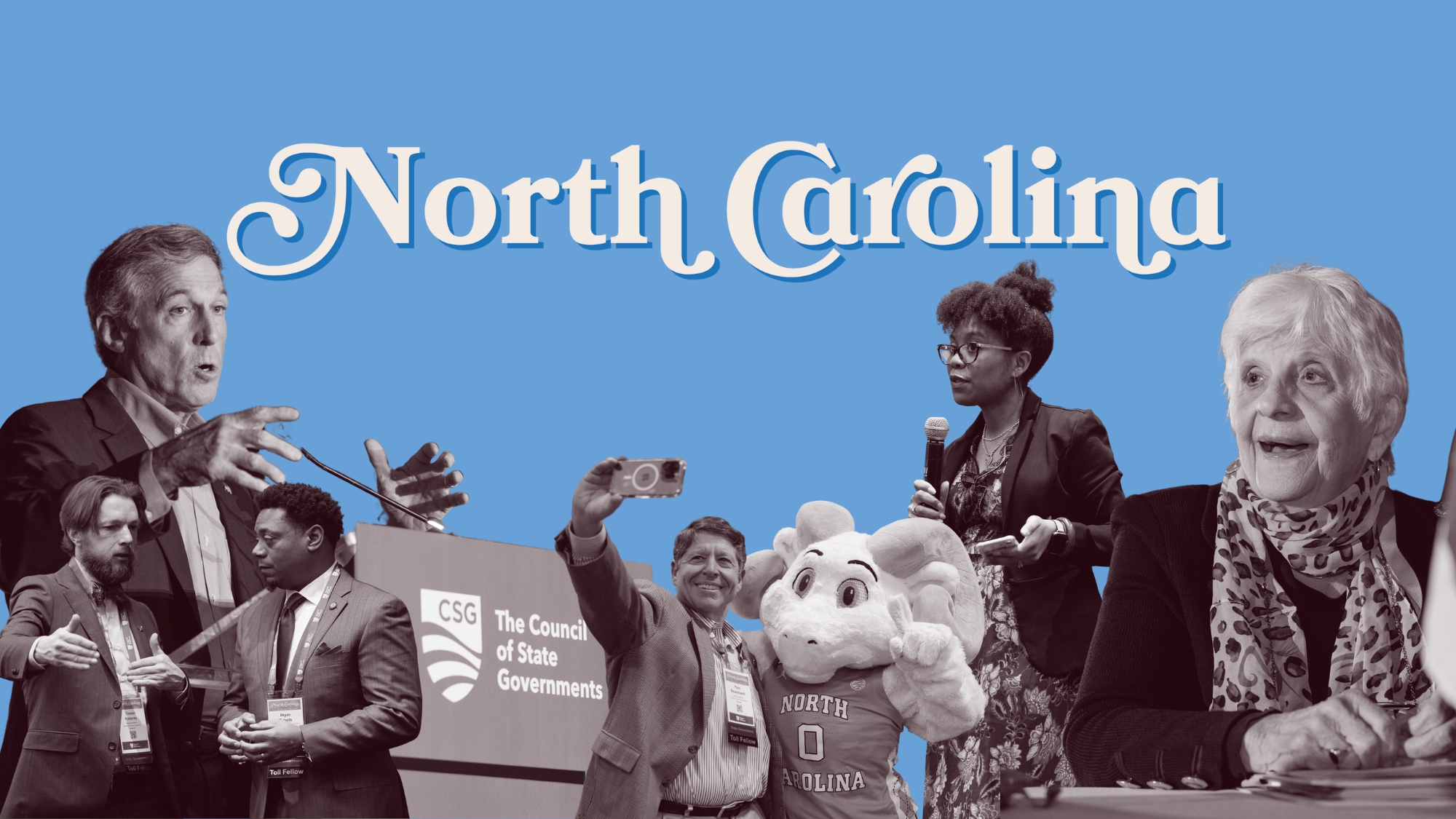For every 100 open jobs in North Dakota, about 27 people are available to fill them.
No other state had a worker shortage as severe as North Dakota’s, according to the U.S. Chamber of Commerce’s analysis of October data on the nation’s labor force.
The legislative response to this persistent workforce challenge has included a lengthy set of initiatives to build North Dakota’s homegrown talent pool and attract workers from other states.
This year, lawmakers added another tool — funding for a new Office of Legal Immigration.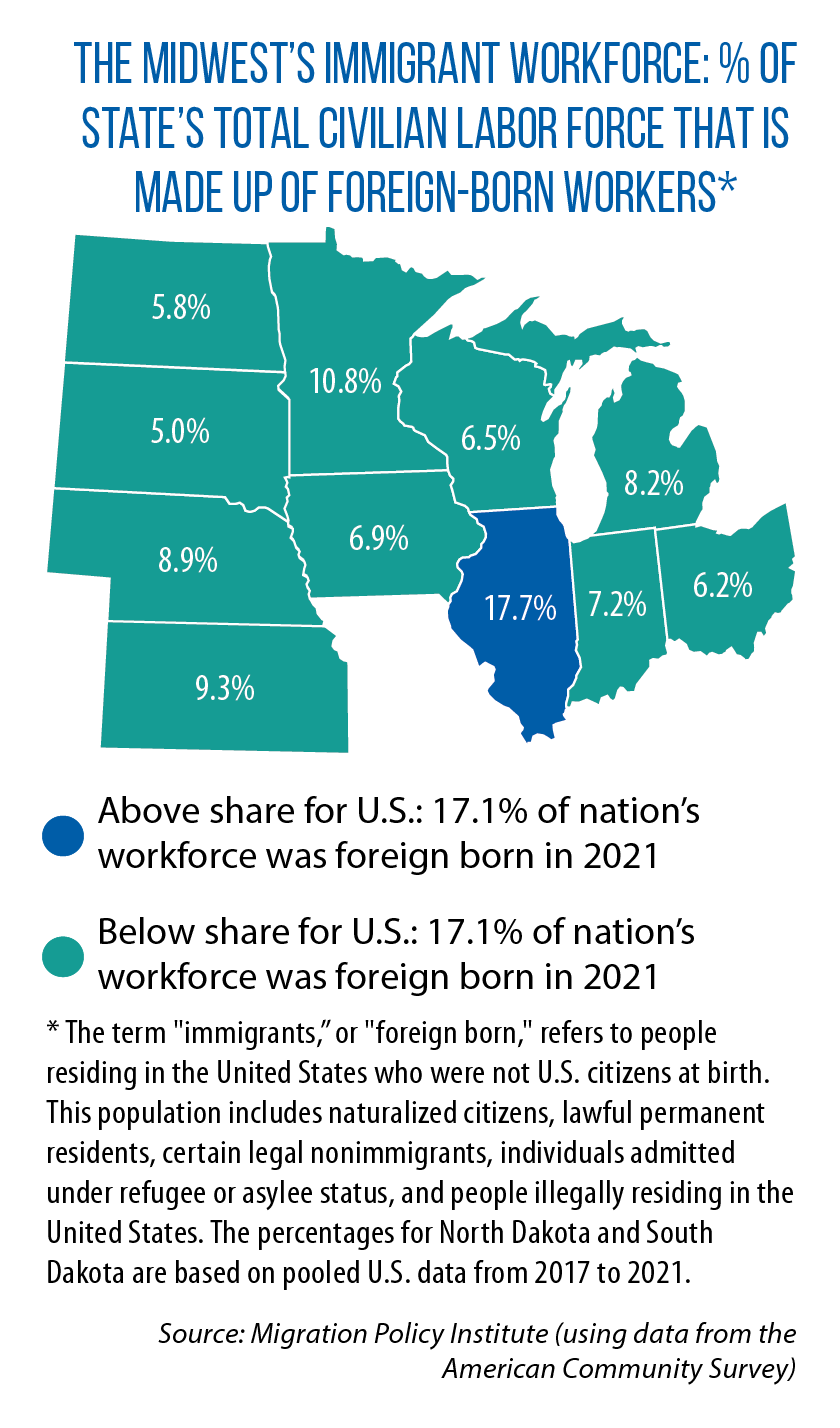
“While we have done good work to promote policies that build up our own pipelines here with North Dakotans and put [individuals] into open positions, our workforce crisis also doesn’t have time to wait just for those solutions to come to fruition,” North Dakota Rep. Zachary Ista said earlier this year on the House floor, pushing for a bill to create the office.
That measure, SB 2142, became law in April.
One month later, legislators in neighboring Minnesota were making permanent an Office of New Americans within that state’s Department of Employment and Economic Development.
These two new state-funded offices in the Midwest go by different names and have been given somewhat different statutory missions.
However, they share at least one common goal: help address the workforce needs of the state and its employers.
Across the border in Canada, meanwhile, a shortage of workers in provinces such as Saskatchewan is causing leaders there to seek more autonomy over immigration policy.
State will help businesses find, retain ‘foreign labor’
North Dakota’s new Office of Legal Immigration is embedded within the state’s Department of Commerce and staffed by two full-time employees (with funding for contract work as well).
Before this kind of designated team was in place, inquiries from businesses about how to obtain immigrant workers or how to navigate federal rules were handled by department staff in an ad hoc fashion.
“It’s a little bit of a phone tree that gets started,” Katie Ralston Howe, the department’s workforce director, said in a legislative committee hearing prior to passage of SB 2142. “It’s not helpful to businesses, and it’s not helpful to us either.”
Although the U.S. Citizenship and Immigration Services does have field offices to answer these questions, Sen. Tim Mathern says local employers don’t always find the assistance they need — not to mention that the closest office is in Minneapolis.
“We have some very large employers who are very astute about [hiring immigrant labor],” explains Mathern, author of SB 2142. “They hire attorneys, they hire other people to work the federal process.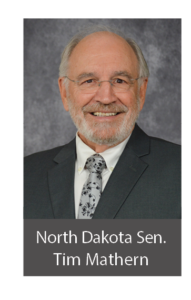
“But small employers do not have that ability. A state office [creates] a focus of expertise that a small, local business could use.”
The initial concept for this office was to address workforce needs in the health care sector. Mathern, who represents parts of the Fargo area, is cognizant of the many African nurses working in the city and even traveled to Nigeria to see firsthand the process it took to immigrate to the United States.
In an effort to get the bill passed, however, the scope of the measure was expanded to include all industry sectors, thus helping secure support from other business groups.
The final version of SB 2142 calls for the new Office of Legal Immigration “to implement a statewide strategy to support businesses in recruiting and retaining foreign labor.” The office is also tasked with helping communities in North Dakota develop immigration integration plans.
Over the next two years, the state will appropriate $485,000 to fund the work of the office and track its progress. By 2025, the legislature wants a fee-based structure in place to help fund the office.
Mathern stresses his motivation for creating such an office was also humanitarian-based, wanting to make it easier for people fleeing oppression and violence to be able to settle in North Dakota for the long term.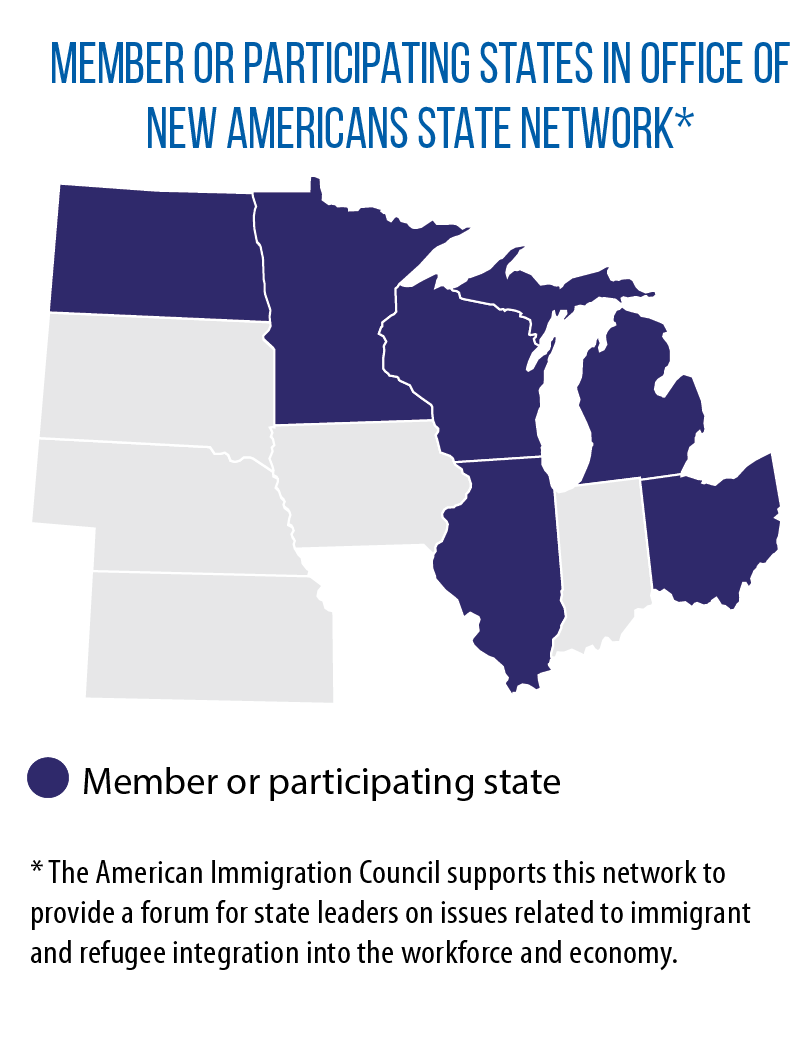
“We don’t just want a worker; we want the family, we want their children, we want their descendants,” he says.
Minnesota establishes Office of New Americans
Until legislative action this year, Minnesota’s Office of New Americans (ONA) was only a temporary entity, but as part of this year’s SF 3035, legislators established the office in statute and provided state funding.
“Immigration, in my mind, should be very boring. … It should be, ‘What are the demographic needs and workforce needs?’ ” says Minnesota Rep. Sandra Feist, who also works as an immigration attorney.
“Nonetheless, it’s a very emotional, polarizing topic. Advancing bills that are explicitly about an immigration-related issue can be politically challenging.”
Early in the year, she introduced a stand-alone bill (HF 330) to make the ONA permanent; that measure ultimately got rolled into the omnibus SF 3035.
Under the new law, the office will create a strategy “to foster and promote immigrant and refugee inclusion in Minnesota so as to improve economic mobility, enhance civic participation, and improve receiving communities’ openness to immigrants and refugees.”
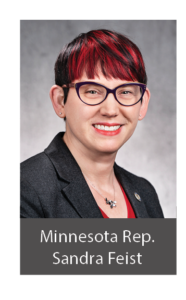 According to American Community Survey data, immigrants made up 8.5 percent of Minnesota’s population and 10.8 percent of its workforce in 2021. After Illinois, these are the highest percentages in the Midwest.
According to American Community Survey data, immigrants made up 8.5 percent of Minnesota’s population and 10.8 percent of its workforce in 2021. After Illinois, these are the highest percentages in the Midwest.
Feist describes the workforce-related purpose of the ONA as creating a network among stakeholders to address issues relating to, for example, professional licensure, language barriers, and improving access to economic development grants.
Minnesota’s ONA also will continue collaborating with on-the-ground partners such as the Neighborhood Development Center, a Twin Cities-based operation whose services include entrepreneur training and business incubators, and “ethnic councils” that provide supports for specific demographic groups.
“I want [the ONA] to have this really comprehensive understanding of the collective needs of our immigrant and refugee communities rather than just understanding what are the very specific needs of the Afghan community, or of the Ukrainian community, or the Hmong community,” Feist says.
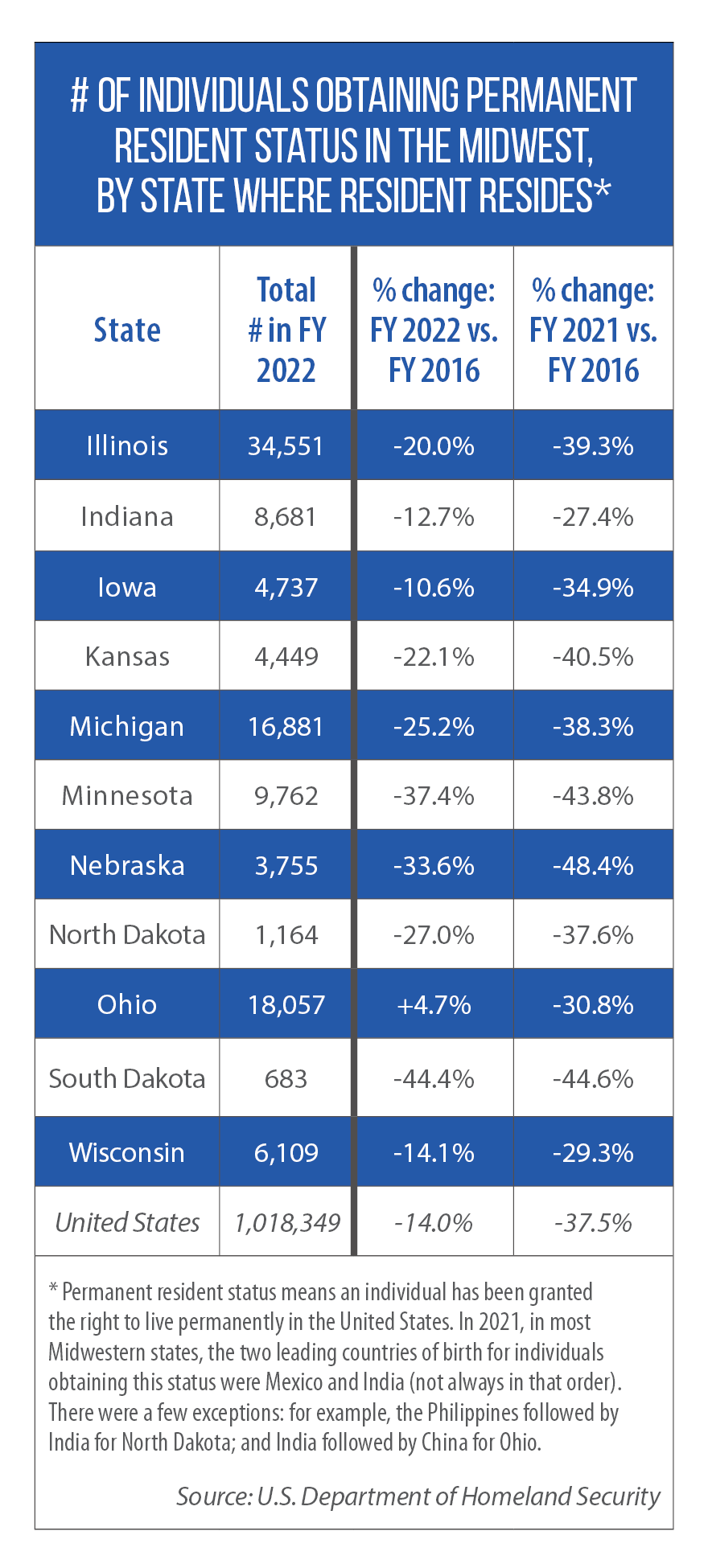 “What I see this office doing is taking a lot of efforts that are going on at the city level, at the ethnic council level, at the charitable level, and bringing all of those threads together and creating a systematic way forward.”
“What I see this office doing is taking a lot of efforts that are going on at the city level, at the ethnic council level, at the charitable level, and bringing all of those threads together and creating a systematic way forward.”
Saskatchewan seeks more control of process
North of the U.S.-Canada border, provincial leaders are seeking greater autonomy over management of parts of that country’s immigrant system, a change being sought to help them address workforce challenges.
In terms of skilled-worker immigration, there currently are two pathways to obtain permanent resident status in Canada beyond the federal Express Entry route.
One of them is the Provincial Nominee Program (PNP), under which provinces are allotted a certain number of immigrants they can nominate for visas in a single year. In this system, applicants earn points based on their language abilities, previous job experiences, postsecondary education, available finances and other factors.
Qualified nominees with high enough scores are then eligible to have their names selected in draws throughout the year.
Another point of entry is immigrating through Québec, which has a system separate from the PNP and sole responsibility for the selection of “economic immigrants” (those who aren’t refugees or sponsored by a family) destined to that province.
In July 2022, a group of immigration-related ministers from Alberta, Manitoba, Ontario and Saskatchewan sent a letter to Canada’s Minister of Immigration, Refugees and Citizenship seeking changes to the current system.
“Provinces best know the needs of their local economies,” the letter said, noting the challenge of addressing “unprecedented labour shortages.” “We need the flexibility to respond to the rapidly evolving needs of specific areas and communities, with a flexible system that we can adapt to changing economic and humanitarian needs.”
In Saskatchewan, the province’s proposed Immigration Accord, modeled in part after Québec’s existing system, calls for an agreement with the Government of Canada that would allow for a greater number of immigrant nominees. That number would be based on the province’s population as a percentage of the whole country, and allow Saskatchewan to exceed this total by 5 percent “for demographic reasons.”
Also under the proposed accord, Saskatchewan would gain sole authority over the selection of economic immigrants to the province, while still recognizing Canada’s authority to determine foreign admission standards and maintaining a shared commitment to reuniting families and promoting multiculturalism.
Saskatchewan leaders said earlier this year that they were continuing to negotiate with the Canadian government over the proposed accord. They also hailed the federal government’s decision to increase Saskatchewan’s allotment of immigrant nominees via the current PNP. That number will reach 8,500 by 2025, an increase of 42 percent from three years earlier.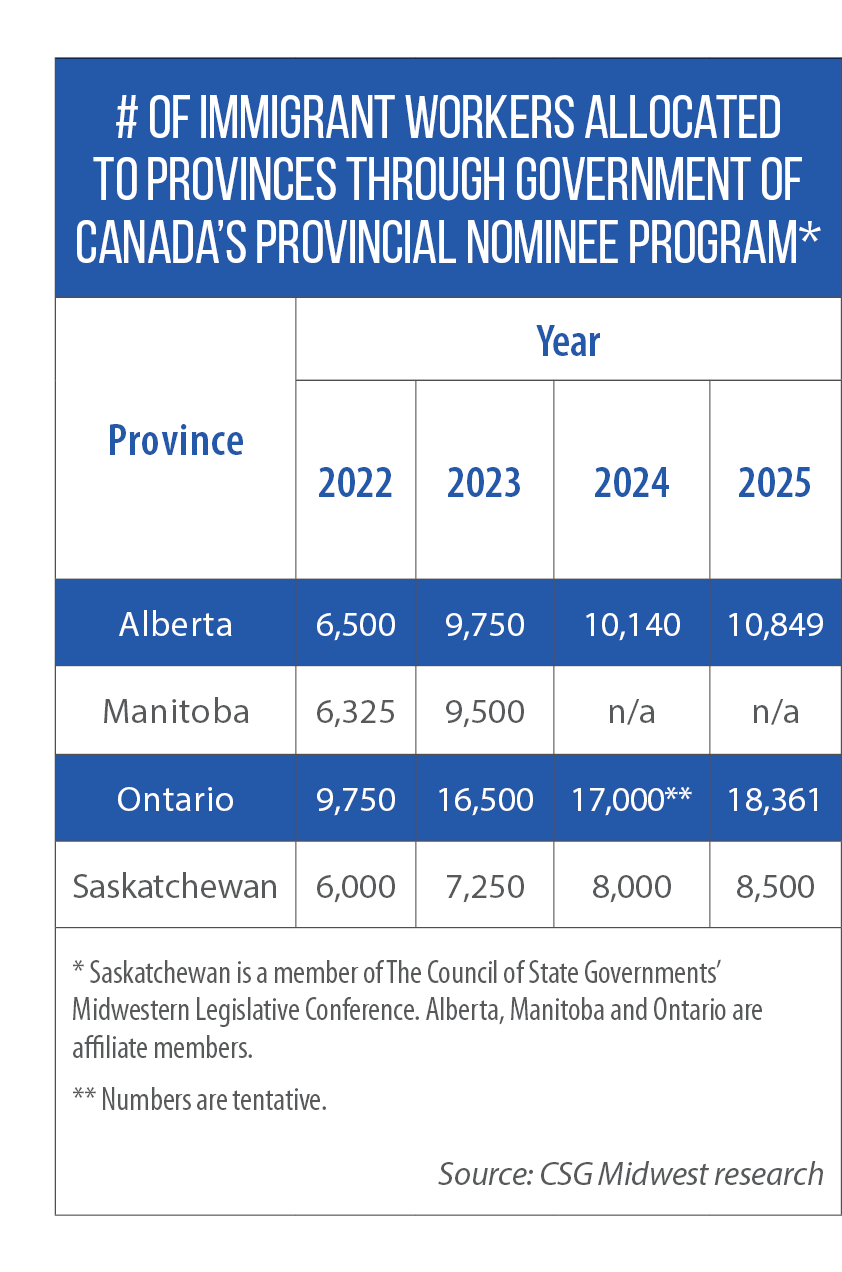
“Saskatchewan is seeing record-high population growth numbers, and immigration to the province has played a significant role in that,” Saskatchewan Immigration and Career Training Minister Jeremy Harrison said in March.
More recently, the CBC reported that the province was launching a pilot program that will reserve 10 percent of its PNP nominations for applicants from eight specific countries — seven European states (the Czech Republic, Germany, Ireland, Lithuania, Poland, Slovakia, and Ukraine) and India.
Immigrants from these countries are most likely to retain permanent residency and stay in Saskatchewan over the long term, provincial officials said. Critics argue this policy will diminish the chances of entry for individuals from non-select countries and harkens back to a restrictive, pre-1967 approach to immigration.
New law accelerates credentialing process
Saskatchewan, meanwhile, also has been changing some of its own, province-specific policies.
A workforce development bill passed last year by the Saskatchewan Legislative Assembly (Bill 81) includes provisions to simplify and accelerate the credentialing process for skilled workers relocating to Saskatchewan from other provinces or countries.
By reducing barriers that prevent new arrivals from working in their profession, Government of Saskatchewan officials told CSG Midwest, the province can help “maximize the benefits of immigration.” Part of the province’s new efforts include creation of a Labour Mobility and Fair Registration Practices Office, which officials say “will provide navigation and financial support to newcomers looking to work in regulated occupations.” Additionally, the office will work with professional regulatory bodies “to speed up and streamline foreign qualification recognition pathways.”
The post States, provinces in region have new plans to build immigration workforce appeared first on CSG Midwest.
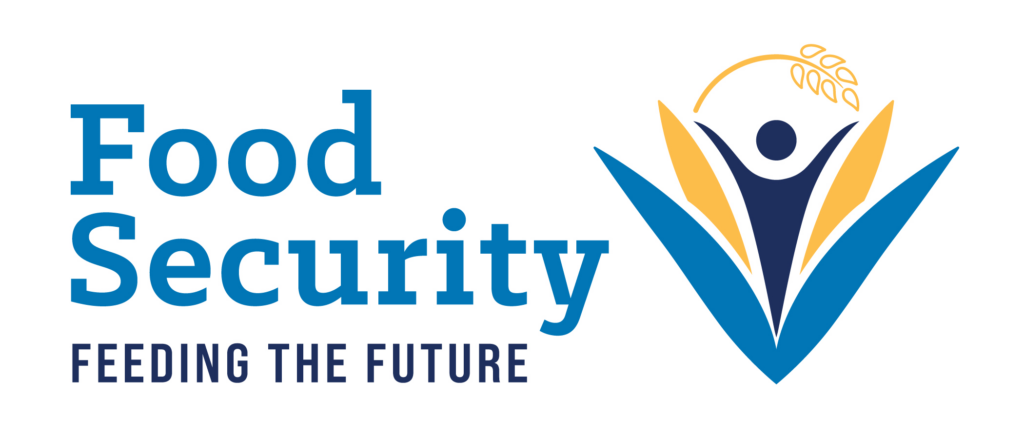 One part of the answer can be the creation and funding of programs that build stronger links between in-state farmers and food banks.
One part of the answer can be the creation and funding of programs that build stronger links between in-state farmers and food banks.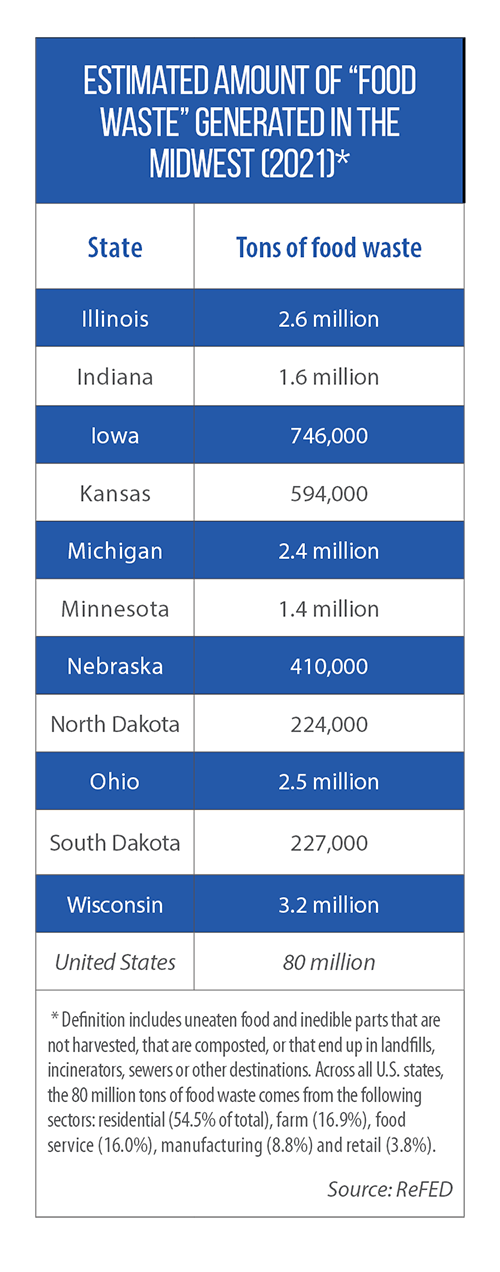 During the two years of the USDA pilot program, nearly 2.5 million pounds of food were donated by Illinois farmers. Legislators have now appropriated $2 million to expand the reach of the program, which will require a dollar-for-dollar match from food banks. These state dollars will help farmers use the food banks as secondary markets for “excess” or “surplus” products that otherwise would have gone to waste.
During the two years of the USDA pilot program, nearly 2.5 million pounds of food were donated by Illinois farmers. Legislators have now appropriated $2 million to expand the reach of the program, which will require a dollar-for-dollar match from food banks. These state dollars will help farmers use the food banks as secondary markets for “excess” or “surplus” products that otherwise would have gone to waste.


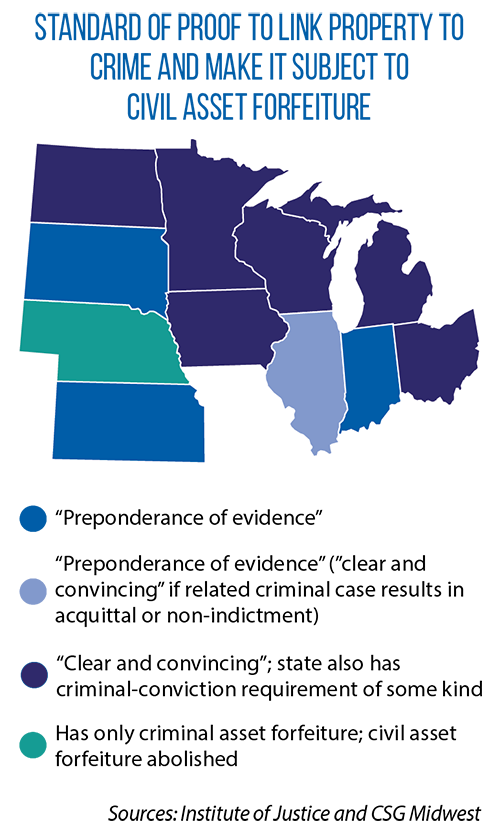 Without such language, the process in most states is unrelated to outcomes in a criminal case. That’s because the property, not an individual, is the subject of the case in a civil proceeding. The standard of proof in these proceedings is lower than “beyond a reasonable doubt,” with one of two standards applied in the Midwestern states: “preponderance of the evidence” or “clear and convincing” (see map).
Without such language, the process in most states is unrelated to outcomes in a criminal case. That’s because the property, not an individual, is the subject of the case in a civil proceeding. The standard of proof in these proceedings is lower than “beyond a reasonable doubt,” with one of two standards applied in the Midwestern states: “preponderance of the evidence” or “clear and convincing” (see map).


 According to
According to  “What I see this office doing is taking a lot of efforts that are going on at the city level, at the ethnic council level, at the charitable level, and bringing all of those threads together and creating a systematic way forward.”
“What I see this office doing is taking a lot of efforts that are going on at the city level, at the ethnic council level, at the charitable level, and bringing all of those threads together and creating a systematic way forward.”


